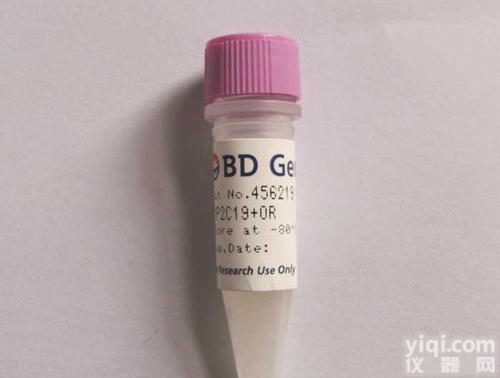货号:
LM-7533R-FITC
保存条件:
-20 °C
浓度:
1mg/ml
应用范围:
IF=1:50-200
形态:
粉末、液体、冻干粉
亚型:
IGg
免疫原:
详见说明书
适应物种:
Human, Mouse, Rat, Dog, Pig, Cow, Rabbit, Goose, Sheep, Chimpanzee,
宿主:
Human, Mouse, Rat, Dog, Pig, Cow, Rabbit, Goose, Sheep, Chimpanzee,
标记物:
FITC标记
抗体名:
Anti-Lipin 1/FITC
抗体英文名:
Anti-Lipin 1/FITC
保质期:
1年
抗原来源:
Rabbit
克隆性:
多克隆
目录编号:
LM-7533R-FITC
级别:
1
靶点:
详见说明书
数量:
大量
供应商:
上海联迈生物工程有限公司
规格:
100ul
FITC标记的磷脂酸磷酸酯酶LPIN1抗体 | 英文名称 | Anti-Lipin 1/FITC |
| 中文名称 | FITC标记的磷脂酸磷酸酯酶LPIN1抗体 |
| 别 名 | KIAA0188; LPIN1; PAP1; Phosphatidate phosphatase LPIN1; LPIN1_HUMAN. |
| 规格价格 | 100ul/2980元 购买 大包装/询价 |
| 说 明 书 | 100ul |
| 研究领域 | 心血管 细胞生物 信号转导 细胞周期蛋白 糖尿病 |
| 抗体来源 | Rabbit |
| 克隆类型 | Polyclonal |
| 交叉反应 | Human, Mouse, Rat, Dog, Pig, Cow, Rabbit, Goose, Sheep, Chimpanzee, |
| 产品应用 | IF=1:50-200
not yet tested in other applications.
optimal dilutions/concentrations should be determined by the end user. |
| 分 子 量 | 99 kDa |
| 细胞定位 | 细胞膜 |
| 性 状 | Lyophilized or Liquid |
| 浓 度 | 1mg/ml |
| 免 疫 原 | KLH conjugated synthetic peptide derived from human Lipin 1 |
| 亚 型 | IgG |
| 纯化方法 | affinity purified by Protein A |
| 储 存 液 | 0.01M TBS(pH7.4) with 1% BSA, 0.03% Proclin300 and 50% Glycerol. |
| 保存条件 | Store at -20 °C for one year. Avoid repeated freeze/thaw cycles. The lyophilized antibody is stable at room temperature for at least one month and for greater than a year when kept at -20°C. When reconstituted in sterile pH 7.4 0.01M PBS or diluent of antibody the antibody is stable for at least two weeks at 2-4 °C. |
| 产品介绍 | background:
Lipin 1 is a member of the Lipin family of nuclear proteins. This family contains three members: Lipin 1, Lipin 2 and Lipin 3, all of which contain a nuclear signal sequence, a highly conserved amino-terminal (NLIP) domain and a carboxy-terminal (CLIP) domain. LPIN1 (Lipin 1) is crucial for normal adipose tissue development and metabolism. LPIN1 selectively activates a subset of PGC1 alpha target pathways, including fatty acid oxidation and mitochondrial oxidative phosphorylation by inducing expression of the nuclear receptor PPARalpha. LPIN1 also inactivates the lipogenic program and suppresses circulating lipid levels. An abundance of LPIN1 promotes fat accumulation and insulin sensitivity, whereas a deficiency in LPIN1 may deter normal adipose tissue development, resulting in insulin resistance and lipodystrophy, a heterogeneous group of disorders characterized by loss of body fat, fatty liver, hypertriglyceridemia and insulin resistance.
Function:
Plays important roles in controlling the metabolism of fatty acids at differents levels. Acts as a magnesium-dependent phosphatidate phosphatase enzyme which catalyzes the conversion of phosphatidic acid to diacylglycerol during triglyceride, phosphatidylcholine and phosphatidylethanolamine biosynthesis in the reticulum endoplasmic membrane. Acts also as a nuclear transcriptional coactivator for PPARGC1A/PPARA to modulate lipid metabolism gene expression (By similarity). Is involved in adipocyte differentiation. May also be involved in mitochondrial fission by converting phosphatidic acid to diacylglycerol (By similarity).
Subunit:
Interacts (via LXXIL motif) with PPARA (By similarity). Interacts with PPARGC1A (By similarity). Interaction with PPARA and PPARGC1A leads to the formation of a complex that modulates gene transcription (By similarity). Interacts with MEF2C (By similarity).
Subcellular Location:
Nucleus membrane (By similarity). Cytoplasm, cytosol (By similarity). Endoplasmic reticulum membrane (By similarity).
Tissue Specificity:
Specifically expressed in skeletal muscle. Also abundant in adipose tissue. Lower levels in some portions of the digestive tract.
Post-translational modifications:
Phosphorylated at multiple sites in response to insulin. Phosphorylation is controlled by the mTOR signaling pathway. Phosphorylation is decreased by epinephrine. Phosphorylation may not directly affect the catalytic activity but may regulate the localization. Dephosphorylated by the CTDNEP1-CNEP1R1 complex (By similarity).
Sumoylated (By similarity).
DISEASE:
Defects in LPIN1 are a cause of autosomal recessive acute recurrent myoglobinuria (ARARM) [MIM:268200]; also known as acute recurrent rhabdomyolysis. Recurrent myoglobinuria is characterized by recurrent attacks of rhabdomyolysis (necrosis or disintegration of skeletal muscle) associated with muscle pain and weakness and followed by excretion of myoglobin in the urine. Renal failure may occasionally occur. Onset is usually in early childhood under the age of 5 years.
Similarity:
Belongs to the lipin family.
Database links: Entrez Gene: 23175 Human Entrez Gene: 14245 Mouse Entrez Gene: 313977 Rat Omim: 605518 Human SwissProt: Q14693 Human SwissProt: Q91ZP3 Mouse Unigene: 467740 Human Unigene: 153625 Mouse
Important Note:
This product as supplied is intended for research use only, not for use in human, therapeutic or diagnostic applications. |
 FITC标记的磷脂酸磷酸酯酶LPIN1抗体
FITC标记的磷脂酸磷酸酯酶LPIN1抗体
 FITC标记的磷脂酸磷酸酯酶LPIN1抗体
FITC标记的磷脂酸磷酸酯酶LPIN1抗体
 FITC标记的磷脂酸磷酸酯酶LPIN1抗体
FITC标记的磷脂酸磷酸酯酶LPIN1抗体
 Lipin 1抗体,磷脂酸磷酸酯酶LPIN1抗体
Lipin 1抗体,磷脂酸磷酸酯酶LPIN1抗体
 Lipin 1抗体,磷脂酸磷酸酯酶LPIN1抗体FITC.PE
Lipin 1抗体,磷脂酸磷酸酯酶LPIN1抗体FITC.PE
 磷脂酸磷酸酯酶LPIN1抗体,Lipin 1,Lipin 1抗体
磷脂酸磷酸酯酶LPIN1抗体,Lipin 1,Lipin 1抗体
 磷脂酸磷酸酯酶LPIN1抗体,Lipin 1,Lipin 1抗体
磷脂酸磷酸酯酶LPIN1抗体,Lipin 1,Lipin 1抗体
 Anti-Lipin 1抗体 磷脂酸磷酸酯酶LPIN1抗体
Anti-Lipin 1抗体 磷脂酸磷酸酯酶LPIN1抗体
 Anti-Lipin 1抗体 磷脂酸磷酸酯酶LPIN1抗体
Anti-Lipin 1抗体 磷脂酸磷酸酯酶LPIN1抗体
 Anti-Lipin 1抗体 磷脂酸磷酸酯酶LPIN1抗体
Anti-Lipin 1抗体 磷脂酸磷酸酯酶LPIN1抗体
 Anti-Lipin 1抗体,磷脂酸磷酸酯酶LPIN1抗体
Anti-Lipin 1抗体,磷脂酸磷酸酯酶LPIN1抗体
 Anti-Lipin 1抗体磷脂酸磷酸酯酶LPIN1抗体
Anti-Lipin 1抗体磷脂酸磷酸酯酶LPIN1抗体